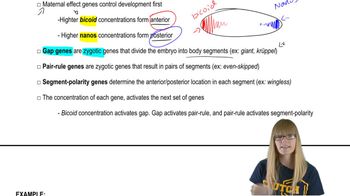Three-spined stickleback fish live in lakes formed when the last ice age ended 10,000 to 15,000 years ago. In lakes where the sticklebacks are prey for larger fish, they develop 35 bony plates along their body as armor. In contrast, sticklebacks in lakes where there are no predators develop only a few or no bony plates. Loss-of-function mutations in the coding region of the homologous gene in humans result in loss of hair, teeth, and sweat glands, as in the toothless men of Sind (India). What does this suggest about hair, teeth, and sweat glands in humans?
Table of contents
- 1. Introduction to Genetics51m
- 2. Mendel's Laws of Inheritance3h 37m
- 3. Extensions to Mendelian Inheritance2h 41m
- 4. Genetic Mapping and Linkage2h 28m
- 5. Genetics of Bacteria and Viruses1h 21m
- 6. Chromosomal Variation1h 48m
- 7. DNA and Chromosome Structure56m
- 8. DNA Replication1h 10m
- 9. Mitosis and Meiosis1h 34m
- 10. Transcription1h 0m
- 11. Translation58m
- 12. Gene Regulation in Prokaryotes1h 19m
- 13. Gene Regulation in Eukaryotes44m
- 14. Genetic Control of Development44m
- 15. Genomes and Genomics1h 50m
- 16. Transposable Elements47m
- 17. Mutation, Repair, and Recombination1h 6m
- 18. Molecular Genetic Tools19m
- 19. Cancer Genetics29m
- 20. Quantitative Genetics1h 26m
- 21. Population Genetics50m
- 22. Evolutionary Genetics29m
14. Genetic Control of Development
Developmental Patterning Genes
Problem 23
Textbook Question
The flowering jungle plant Lacandonia schismatica, discovered in southern Mexico, has a unique floral structure. Petal-like organs are in the outer whorls surrounding a number of carpels, and stamens are in the center of the flower. Closely related species are dioecious; female plants bear flowers that resemble those of Lacandonia, but without the central stamens. What type of mutation could have resulted in the evolution of Lacandonia flowers?
 Verified step by step guidance
Verified step by step guidance1
Understand the floral structure of Lacandonia schismatica: The plant has a unique arrangement where stamens (male reproductive organs) are located in the center, surrounded by carpels (female reproductive organs) and petal-like organs. This differs from closely related dioecious species, which have separate male and female plants.
Review the concept of homeotic mutations: Homeotic mutations are genetic changes that result in the transformation of one organ type into another. In plants, these mutations often affect genes in the ABC model of flower development, which governs the identity of floral organs.
Consider the role of B-class genes: In the ABC model, B-class genes (such as APETALA3 and PISTILLATA) are responsible for the development of stamens and petals. A mutation in these genes could lead to altered organ placement or identity, potentially explaining the central stamens in Lacandonia.
Explore the possibility of ectopic expression: Ectopic expression refers to the activation of genes in an unusual location. If B-class genes were expressed in the center of the flower instead of their normal location, this could result in stamens forming in the center rather than the outer whorls.
Hypothesize the evolutionary significance: The mutation leading to Lacandonia's floral structure may have provided an adaptive advantage, such as improved pollination efficiency or reproductive success, driving its evolution and persistence in the population.
 Verified video answer for a similar problem:
Verified video answer for a similar problem:This video solution was recommended by our tutors as helpful for the problem above
Video duration:
3mPlay a video:
Was this helpful?
Key Concepts
Here are the essential concepts you must grasp in order to answer the question correctly.
Mutation Types
Mutations are changes in the DNA sequence that can lead to variations in traits. They can be classified into several types, including point mutations, insertions, deletions, and duplications. Each type can affect gene function differently, potentially leading to phenotypic changes such as the unique floral structure observed in Lacandonia schismatica.
Recommended video:
Guided course

Mutations and Phenotypes
Dioecy
Dioecy refers to a plant reproductive strategy where individual plants are either male or female, leading to distinct sexual morphologies. In dioecious species, such as those related to Lacandonia, the separation of sexes can drive evolutionary changes in floral structures, as adaptations may arise to enhance reproductive success in specific environments.
Evolutionary Developmental Biology (Evo-Devo)
Evo-Devo is a field that studies the relationship between the development of an organism and its evolutionary processes. It examines how changes in developmental pathways can lead to morphological diversity, such as the evolution of unique flower structures in Lacandonia. Understanding these developmental mechanisms can provide insights into how mutations may have shaped the plant's reproductive features.
Recommended video:
Guided course

Segmentation Genes
Related Videos
Related Practice
Textbook Question
544
views


